• Derrick Henry has been an elite rusher: Henry’s PFF rushing grade has consistently been among the best at the position, including last season, and it doesn’t seem like that will stop with the Baltimore Ravens.
• The Ravens offensive line can help him: Henry’s been great when the offensive line doesn’t mess up. Luckily, the Ravens offensive line doesn't mess up often.
• Get a head start on fantasy football: Use PFF's fantasy football mock draft simulator to create real live mock draft simulations to get ready for your live draft!
Estimated reading time: 6 minutes
The player profile series gives the most in-depth view of a player possible using the best data points at PFF’s disposal to look at how good the player has performed, what competition the player has for touches, and how other teammates and coaches will impact each player's performance.
Last updated: 7:15 a.m. Monday, July 8
Player performance
Henry has been among the league leaders in carries per game, which has helped him to some of the best rushing and fantasy seasons throughout his career. His per-attempt numbers have just been average, but it’s worth remembering that offensive lines have a lot to do with rushing production.
When Henry was at his peak in 2019 and 2020, he had Ben Jones and Rodger Saffold leading the way on the Tennessee Titans‘ interior line, Taylor Lewan and Jack Conklin playing well when available, and Nate Davis and Dennis Kelly still grading above replacement level to fill out the line. Over the last three seasons, the Titans have 20 offensive linemen with at least 100 snaps, including nine last season. Five of the nine graded below replacement level, and none of the six players from his peak seasons remained.
Henry has still thrived on perfectly blocked plays, so he can still be a great back when given the opportunity. He also played well against an eight-man box, which he could still see a lot of with the Baltimore Ravens.
In the passing game, he simply doesn’t run many routes, but from an efficiency standpoint, he’s played well enough when given the opportunity.
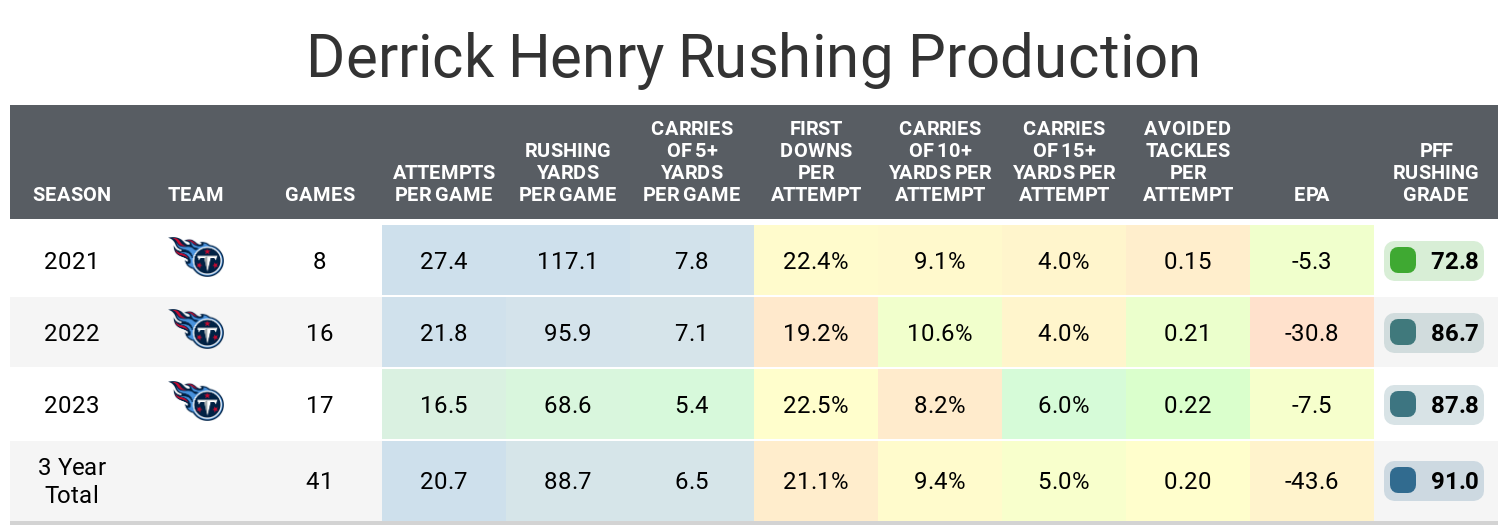
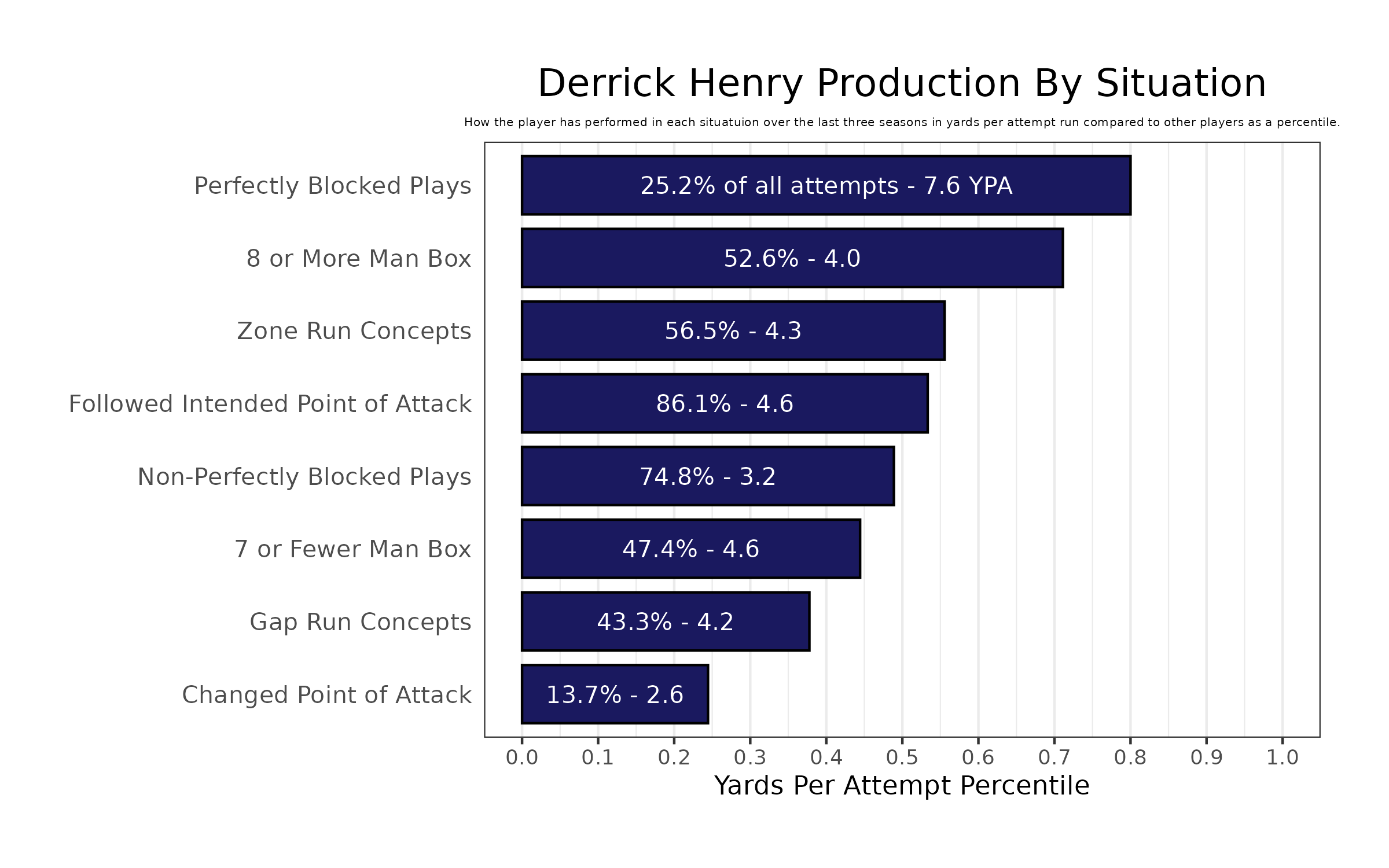
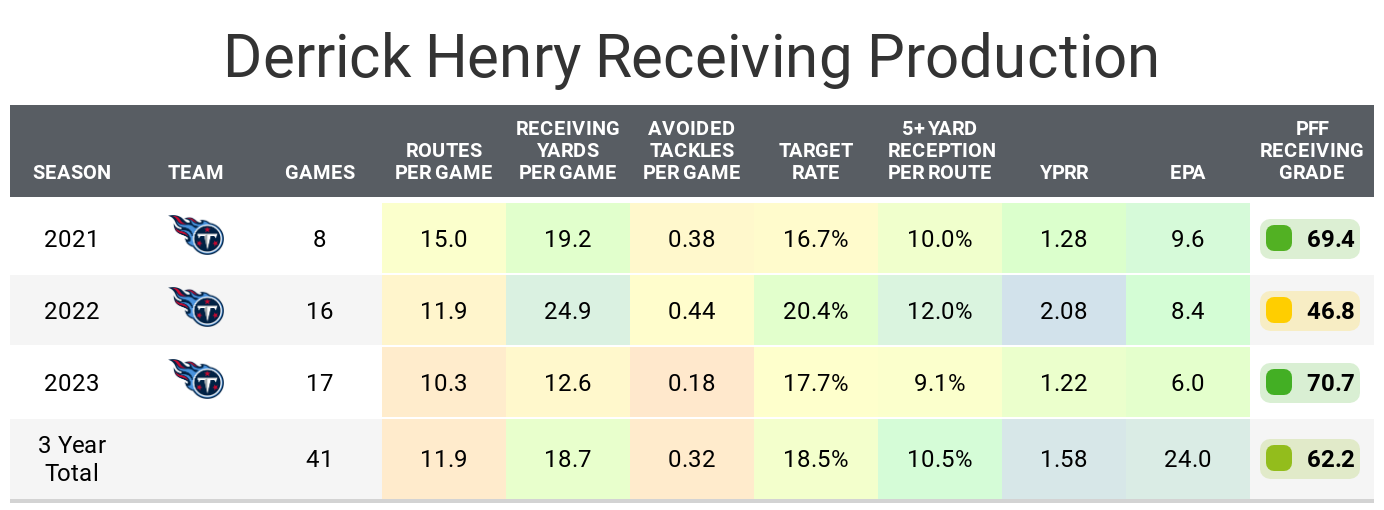
Competition for touches
Henry has largely been used on early downs, at the goal line and in short-yardage situations. He has played fewer snaps in those situations over time partly because the Titans had Tyjae Spears last season. Henry’s snap count in those situations could remain high this season with minimal competition. Justice Hill will start the season as the Ravens' top backup. He is more of a receiving back and is the clear favorite for third-down and two-minute drill snaps. He has played on early downs when there have been injuries.
Keaton Mitchell had an excellent rookie season, but he tore his ACL in Week 15, so we already know he won’t be ready for Week 1. We’ve seen plenty of cases of running backs not being 100% even when they are capable of playing. Until Mitchell is ready, Rasheen Ali could be a primary backup on early downs. If Henry suffers an injury early in the season, Ali may earn significant playing time.
The biggest concern for Henry’s fantasy value is sharing a backfield with Lamar Jackson. Ignoring scrambles, fumbled snaps and kneel-downs, Jackson ran the ball 71 times on designed runs last year compared to the Titans quarterbacks combining for seven. On the bright side, there were only four times when the Ravens were within four yards of scoring compared to 24 runs by running backs. Jackson might cost Henry three to four carries per game, but it shouldn’t eat into his touchdown production.
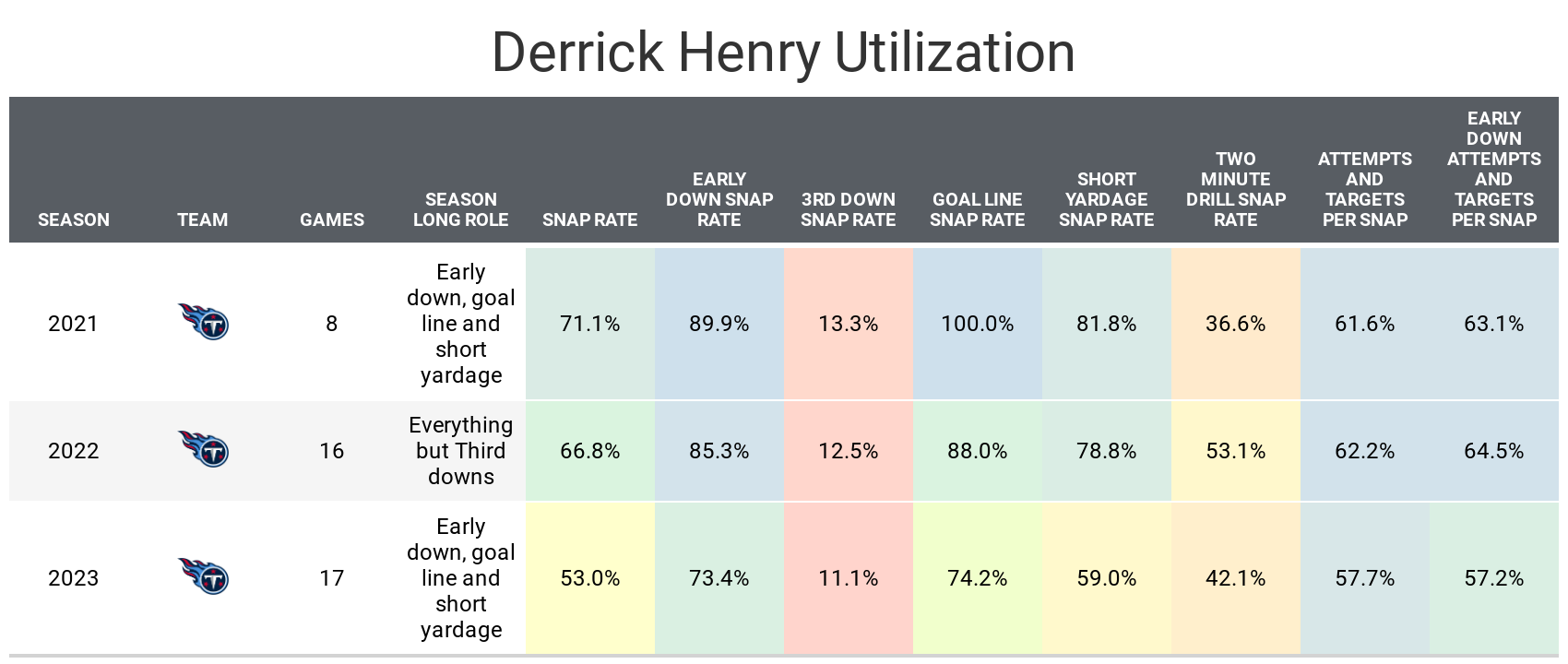

Impact of teammates
The Ravens offensive line should be uniquely suited to help Henry be productive on a per-play basis. By their PFF run grades, only Tyler Linderbaum should be an asset, but they’ve been good at preventing negative plays and bad at creating good plays. This wouldn’t be great for an average running back, but considering how good Henry has been on perfectly blocked plays, this should be great news for the former 2,000-yard rusher. Henry should see a significant increase in perfectly blocked plays, leading to a higher rushing average.
Todd Monken, in particular, shouldn’t have a particularly good or bad impact on Henry. Nick Chubb was RB8 in 2019 when Monken was the offensive coordinator. Chubb was similarly a great early down back who barely played in the passing game. His running backs didn’t have nearly the same success when he was the Tampa Bay Buccaneers‘ offensive coordinator, but Peyton Barber, Jacquizz Rodgers and Charles Sims recorded the most snaps for Tampa Bay at running back during that time.
It will generally help to be on the Baltimore Ravens offense. Henry led the league in rushing touchdowns in 2019 and 2020 with 16 and 17 respectively. He still ran for double-digit touchdowns each of the last three seasons despite the Titans being in the bottom quarter of the league in red-zone plays. The Ravens have been in the top quarter.

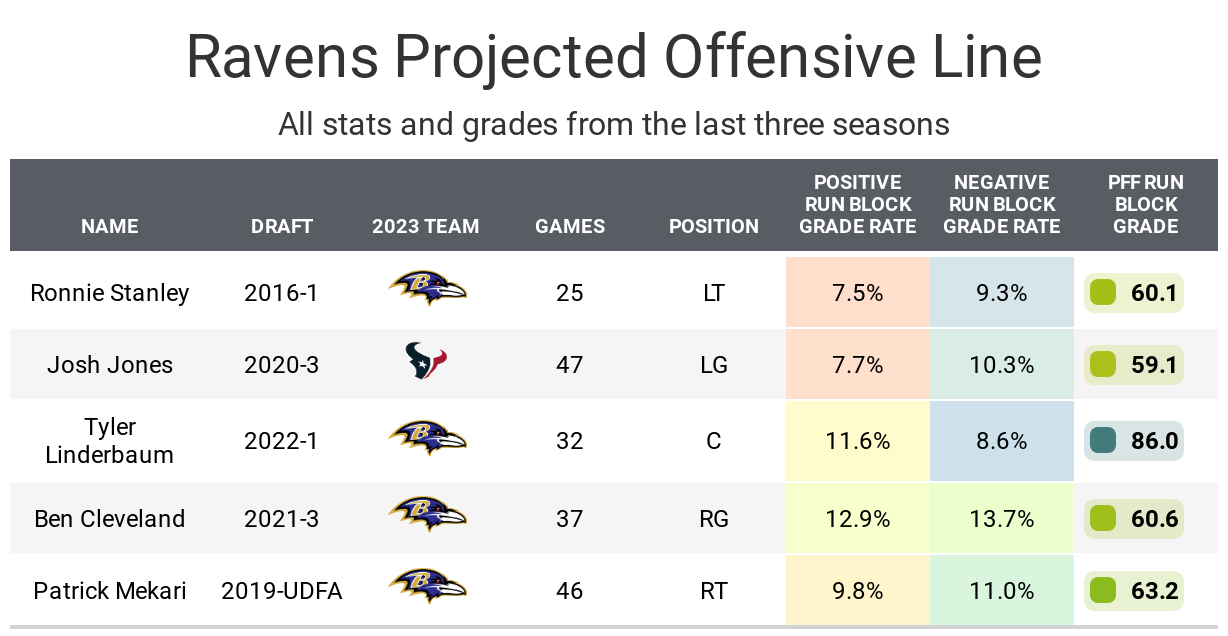
Bottom line
Henry has been an elite fantasy running back during his career, and despite being 30 years old, he should be in store for another excellent season. The only concern is volume, as Lamar Jackson will take a few carries away from Henry, and the team may try to preserve him for a playoff push.

Footnotes
- Statistics for the tables and charts were generally chosen based on their ability to predict future fantasy performance on either per game or per opportunity basis, or chosen for their ability to describe the player relative to other players at the same position.
- Opportunities for this purpose are defined by passing dropbacks, rushing attempts and receiving routes run.
- Numbers are either by season or based on the last three years. For rookies, only college numbers are included. For non-rookies, only NFL numbers are included, even if they played in college in the last three years.
- Because college competition is relatively easier than NFL competition, it can be expected that most rookies will see a decline in their numbers compared to their historic numbers.
- For all of the tables in this article, colors range from blue (good or high) to red (bad or low).
- All percentiles or colors compare the given player to other players with a high sample of opportunities. Generally, it’s one-third of the possible opportunities given the sample. If the player in question doesn’t have enough opportunities, they are still compared, even though a player could look good or bad on that small sample size which might not be as predictive.
- Information on running back utilization classifications and importance can be found here, wide receiver here and tight end here.
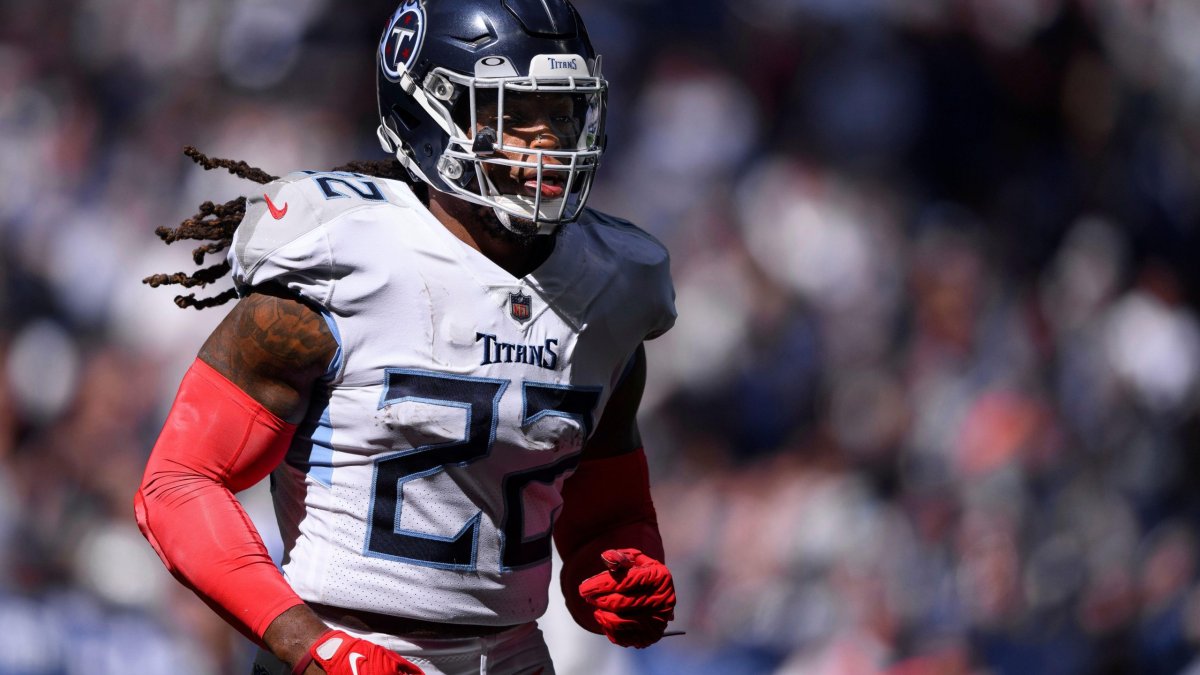



 © 2024 PFF - all rights reserved.
© 2024 PFF - all rights reserved.